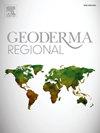从水田到天然湿地:演替阶段的土壤质量
IF 3.3
2区 农林科学
Q2 SOIL SCIENCE
引用次数: 0
摘要
撂荒后的自然演替促进了湿地土壤的生态恢复,但对湿地土壤性质和质量随时间变化趋势的系统研究较少。本研究评估了不同撂撂期湿地土壤理化性质和质量的动态变化,以阐明土壤质量恢复的驱动因素。在中国图们江下游选择了5个地点:稻田(PF);5年(Ab5)、15年(Ab15)和30年(Ab30)的湿地恢复;和天然湿地(西北)。采用主成分分析法评价撂撂期与土壤性质变化的关系,采用最小数据集评价土壤质量,以全氮、速效氮、全磷和速效磷为核心指标。结果表明,土壤性质在上层和下层之间存在显著差异,其中Ab5与其他恢复湿地的差异最为显著。全氮在两个土层深度对土壤质量指标的影响最大。随着演替,上层土壤逐渐恢复,但农业活动仍造成养分流失,下层土壤恢复滞后。土壤质量指数最高的是Ab30,其次是Ab15、Ab5、NW和PF,说明演替对土壤质量有正向影响。这些发现突出了关键的土壤指标,为退化湿地的恢复和可持续管理提供了见解。这些发现可以纳入适应性管理战略,以增强生态弹性和促进可持续土地利用。本文章由计算机程序翻译,如有差异,请以英文原文为准。
From paddy fields to natural wetlands: Soil quality across successional stages
Natural succession following farmland abandonment promotes ecological restoration of wetland soils, yet systematic studies on soil property and quality trends in wetlands over time are scarce. This study evaluated the dynamic changes in soil physicochemical properties and quality across wetlands with varying abandonment durations to elucidate drivers of soil quality restoration. Five sites were selected in the downstream Tumen River, China: paddy fields (PF); restored wetlands abandoned for 5 (Ab5), 15 (Ab15), and 30 years (Ab30); and natural wetlands (NW). Principal Component Analysis was employed to evaluate the relationship between abandonment duration and soil property changes, while Minimum Data Set was used to assess soil quality, with total nitrogen, available nitrogen, total phosphorus, and available phosphorus as core indicators. The results revealed significant differences in soil properties between the upper and lower soil layers, with the most pronounced differences observed in Ab5 compared to other restored wetlands. Total nitrogen had the greatest influence on the soil quality index at both soil depths. The upper soil layer gradually recovered with succession, although agricultural activities still contributed to nutrient loss, while lower layer recovery lagged behind. Ab30 exhibited the highest soil quality index, followed by Ab15, Ab5, NW, and PF, confirming the positive effect of succession on soil quality. These findings highlight critical soil indicators, offering insights for the restoration and sustainable management of degraded wetlands. These findings can be integrated into adaptive management strategies to enhance ecological resilience and promote sustainable land use.
求助全文
通过发布文献求助,成功后即可免费获取论文全文。
去求助
来源期刊

Geoderma Regional
Agricultural and Biological Sciences-Soil Science
CiteScore
6.10
自引率
7.30%
发文量
122
审稿时长
76 days
期刊介绍:
Global issues require studies and solutions on national and regional levels. Geoderma Regional focuses on studies that increase understanding and advance our scientific knowledge of soils in all regions of the world. The journal embraces every aspect of soil science and welcomes reviews of regional progress.
 求助内容:
求助内容: 应助结果提醒方式:
应助结果提醒方式:


